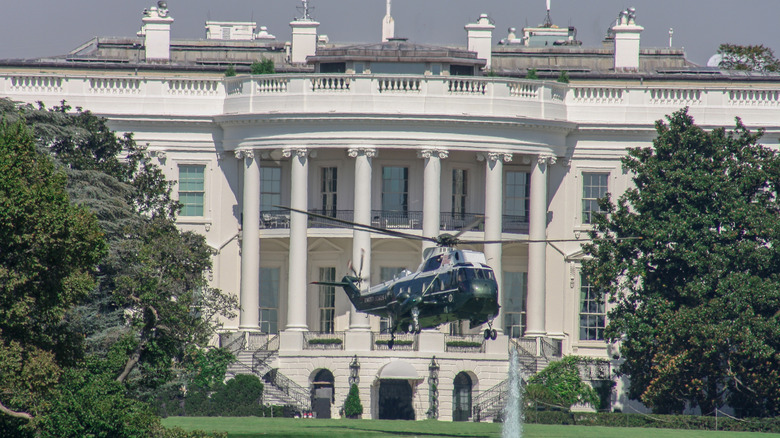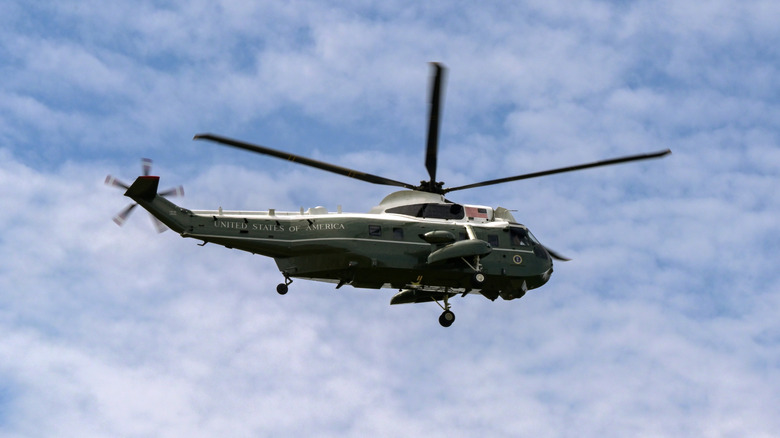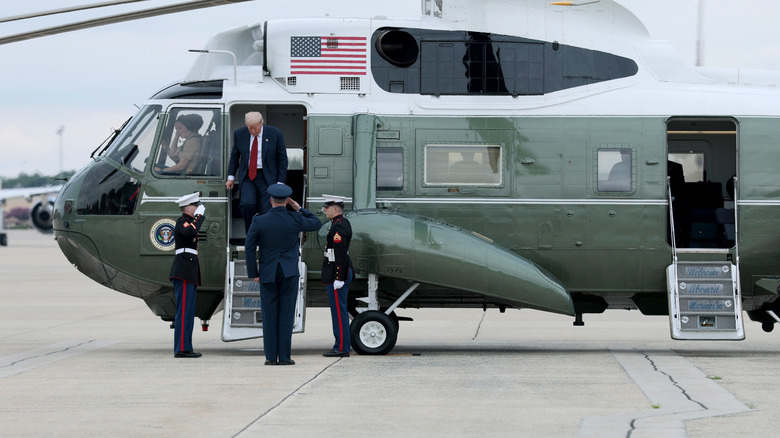Marine One: What Makes The Presidential Helicopter So Special?
Marine One, much like the similarly named Air Force One (which has some amazing features of its own), is operated by Marine Helicopter Squadron One (HMX-1), a specialized unit that has flown the president since 1957. Whether it's the VH-3D Sea King or the VH-60N White Hawk, the bird is built for one purpose: getting the Commander-in-Chief from point A to point B in the shortest time possible and in maximum security and comfort.
Depending on the model, Marine One fits between 11 and 14 people. The VH-3D seats 14, while the smaller VH-60N carries 11. There's also a bathroom on board, basic refreshments like water and snacks, and even boxes of official presidential M&Ms. The new VH-92s were designed to replace the older models, though their rollout has been hit-or-miss due to practical issues, like scorching the White House lawn on landing.
It's most often seen lifting off from the White House South Lawn for the short hop to Joint Base Andrews, where Air Force One is stationed. This flight takes just minutes compared to the longer, more vulnerable journey by motorcade through city streets. It's also used to reach Camp David in Maryland or other local destinations where a helicopter offers a faster and more secure route. Whether operating in Washington, D.C., or overseas, the aircraft must always be ready for its no-fail mission: safely transporting the president with the highest level of security possible.
Designed like a fortress, not a lounge
At a glance, the layout is merely functional. There's no gold trim or velvet curtains. Instead, you'll find light-toned leather seating, polished wood accents, and a captain's chair facing forward — the only one besides the pilots'. That's the president's seat. While it looks like a standard high-end helicopter from the outside, it's surrounded by VIP-grade armor, radar jammers, and anti-missile tech. The airframe includes ballistic shielding and energy-absorbing landing gear. In case of impact, self-sealing fuel tanks help prevent fire. Standard military countermeasures like flares and chaff are also installed to counter heat-seeking and radar-guided missiles. This thing is a fortress in the sky, not a plush commuter.
The whole helicopter is soundproofed to allow confidential conversations mid-flight. When presidents hold working meetings on board, they don't have to shout or whisper. It's also outfitted with secure communication systems so they can take sensitive calls without disruption.
Marine One can be deployed worldwide, often transported aboard C-17 Globemaster or C-5 Galaxy aircraft alongside the presidential limousine (no, Air Force One doesn't carry it). A decoy formation is always in the air. Marine One rarely flies solo. It takes off alongside up to four other helicopters that swap positions mid-air to confuse anyone tracking the real flight path. All are visually identical, and passengers often can't tell which is the real Marine One from the outside. This is part of the standard operating procedure, not a rare contingency. All HMX-1 personnel must pass a stringent Yankee White background check, ensuring maximum trust and security clearance.
History and evolution
Marine One's history began in 1957 when President Dwight D. Eisenhower became the first to use a helicopter for official travel, boarding a Bell UH-13J Sioux to reach his summer home in Pennsylvania. The shift to helicopter transport was prompted by the need for a quicker, more direct route than Air Force One could offer for short trips. The Sioux was soon replaced by the larger Sikorsky H-34 Seahorse, which offered more seating and greater range.
In 1961, the VH-3A Sea King entered service, introducing turboshaft engines for better power and reliability. By 1978, the VH-3D had joined the fleet, and in 1988, the VH-60N White Hawk was added. Both types served together for decades, undergoing upgrades to meet evolving mission requirements. However, by the early 2000s, the weight of added equipment limited further improvements. Plans for a replacement began with the ill-fated VH-71 Kestrel program, which was canceled in 2009 due to soaring costs.
The current replacement effort resulted in the VH-92A Patriot, derived from the Sikorsky S-92, entering service in the 2020s. Older VH-3Ds and VH-60Ns are being phased out gradually to ensure no disruption to service. Through every upgrade, the aircraft have retained the distinctive green and white "White Tops" paint scheme, a visual symbol of the presidency. From the first flights in the 1950s to today's advanced fleet, Marine One has remained a constant in presidential travel.


